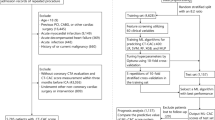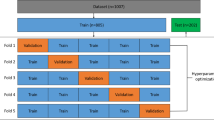Abstract
Objectives
To evaluate the long-term prognostic value of coronary CT angiography (cCTA)-derived plaque measures and clinical parameters on major adverse cardiac events (MACE) using machine learning (ML).
Methods
Datasets of 361 patients (61.9 ± 10.3 years, 65% male) with suspected coronary artery disease (CAD) who underwent cCTA were retrospectively analyzed. MACE was recorded. cCTA-derived adverse plaque features and conventional CT risk scores together with cardiovascular risk factors were provided to a ML model to predict MACE. A boosted ensemble algorithm (RUSBoost) utilizing decision trees as weak learners with repeated nested cross-validation to train and validate the model was used. Performance of the ML model was calculated using the area under the curve (AUC).
Results
MACE was observed in 31 patients (8.6%) after a median follow-up of 5.4 years. Discriminatory power was significantly higher for the ML model (AUC 0.96 [95%CI 0.93–0.98]) compared with conventional CT risk scores including Agatston calcium score (AUC 0.84 [95%CI 0.80–0.87]), segment involvement score (AUC 0.88 [95%CI 0.84–0.91]), and segment stenosis score (AUC 0.89 [95%CI 0.86–0.92], all p < 0.05). Similar results were shown for adverse plaque measures (AUCs 0.72–0.82, all p < 0.05) and clinical parameters including the Framingham risk score (AUCs 0.71–0.76, all p < 0.05). The ML model yielded significantly higher diagnostic performance compared with logistic regression analysis (AUC 0.96 vs. 0.92, p = 0.024).
Conclusion
Integration of a ML model improves the long-term prediction of MACE when compared with conventional CT risk scores, adverse plaque measures, and clinical information. ML algorithms may improve the integration of patient’s information to enhance risk stratification.
Key Points
• A machine learning (ML) model portends high discriminatory power to predict major adverse cardiac events (MACE).
• ML-based risk stratification shows superior diagnostic performance for MACE prediction over coronary CT angiography (cCTA)-derived risk scores or clinical parameters alone.
• A ML model outperforms conventional logistic regression analysis for the prediction of MACE.



Similar content being viewed by others
Abbreviations
- AUC:
-
Area under the curve
- CAD:
-
Coronary artery disease
- cCTA:
-
Coronary CT angiography
- CV:
-
Cross-validation
- ICA:
-
Invasive coronary angiography
- MACE:
-
Major adverse cardiac events
- ML:
-
Machine learning
- NPV:
-
Negative predictive value
- NSTEMI:
-
Non-ST segment elevation myocardial infarction
- PPV:
-
Positive predictive value
- RI:
-
Remodeling Index
- ROC:
-
Receiver-operating characteristics
- STEMI:
-
ST segment elevation myocardial infarction
References
Min JK, Shaw LJ, Devereux RB et al (2007) Prognostic value of multidetector coronary computed tomographic angiography for prediction of all-cause mortality. J Am Coll Cardiol 50:1161–1170
Tesche C, Plank F, De Cecco CN et al (2016) Prognostic implications of coronary CT angiography-derived quantitative markers for the prediction of major adverse cardiac events. J Cardiovasc Comput Tomogr 10:458–465
Chow BJ, Wells GA, Chen L et al (2010) Prognostic value of 64-slice cardiac computed tomography severity of coronary artery disease, coronary atherosclerosis, and left ventricular ejection fraction. J Am Coll Cardiol 55:1017–1028
Bauer RW, Thilo C, Chiaramida SA, Vogl TJ, Costello P, Schoepf UJ (2009) Noncalcified atherosclerotic plaque burden at coronary CT angiography: a better predictor of ischemia at stress myocardial perfusion imaging than calcium score and stenosis severity. AJR Am J Roentgenol 193:410–418
Motoyama S, Kondo T, Sarai M et al (2007) Multislice computed tomographic characteristics of coronary lesions in acute coronary syndromes. J Am Coll Cardiol 50:319–326
Andreini D, Pontone G, Mushtaq S et al (2017) Long-term prognostic impact of CT-Leaman score in patients with non-obstructive CAD: results from the COronary CT Angiography EvaluatioN For Clinical Outcomes InteRnational Multicenter (CONFIRM) study. Int J Cardiol 231:18–25
Dey D, Slomka PJ, Leeson P et al (2019) Artificial intelligence in cardiovascular imaging: JACC state-of-the-art review. J Am Coll Cardiol 73:1317–1335
Al’Aref SJ, Anchouche K, Singh G et al (2019) Clinical applications of machine learning in cardiovascular disease and its relevance to cardiac imaging. Eur Heart J 40(24):1975–1986
Dey D, Gaur S, Ovrehus KA et al (2018) Integrated prediction of lesion-specific ischaemia from quantitative coronary CT angiography using machine learning: a multicentre study. Eur Radiol 28:2655–2664
Motwani M, Dey D, Berman DS et al (2017) Machine learning for prediction of all-cause mortality in patients with suspected coronary artery disease: a 5-year multicentre prospective registry analysis. Eur Heart J 38(7):500–507
Task Force on the management of ST-segment elevation acute myocardial infarction of the European Society of Cardiology (ESC), Steg PG, James SK et al (2012) ESC Guidelines for the management of acute myocardial infarction in patients presenting with ST-segment elevation. Eur Heart J 33:2569–2619
D’Agostino RB Sr, Vasan RS, Pencina MJ et al (2008) General cardiovascular risk profile for use in primary care: the Framingham Heart Study. Circulation 117:743–753
Cury RC, Abbara S, Achenbach S et al (2016) CAD-RADS(TM) coronary artery disease - reporting and data system. An expert consensus document of the Society of Cardiovascular Computed Tomography (SCCT), the American College of Radiology (ACR) and the north American Society for Cardiovascular Imaging (NASCI). Endorsed by the American College of Cardiology. J Cardiovasc Comput Tomogr 10:269–281
Achenbach S, Ropers D, Hoffmann U et al (2004) Assessment of coronary remodeling in stenotic and nonstenotic coronary atherosclerotic lesions by multidetector spiral computed tomography. J Am Coll Cardiol 43:842–847
Maurovich-Horvat P, Schlett CL, Alkadhi H et al (2012) The napkin-ring sign indicates advanced atherosclerotic lesions in coronary CT angiography. JACC Cardiovasc Imaging 5:1243–1252
Park HB, Heo R, o Hartaigh B et al (2015) Atherosclerotic plaque characteristics by CT angiography identify coronary lesions that cause ischemia: a direct comparison to fractional flow reserve. JACC Cardiovasc Imaging 8:1–10
Min JK, Feignoux J, Treutenaere J, Laperche T, Sablayrolles J (2010) The prognostic value of multidetector coronary CT angiography for the prediction of major adverse cardiovascular events: a multicenter observational cohort study. Int J Cardiovasc Imaging 26:721–728
Yamamoto H, Kihara Y, Kitagawa T et al (2018) Coronary plaque characteristics in computed tomography and 2-year outcomes: the PREDICT study. J Cardiovasc Comput Tomogr 12:436–443
Seiffert C, Khoshgoftaar TM, Van Hulse J, Napolitano A (2010) RUSBoost: a hybrid approach to alleviating class imbalance. IEEE Trans Syst Man Cybern Part A Syst Hum 40:185–197
van Rosendael AR, Maliakal G, Kolli KK et al (2018) Maximization of the usage of coronary CTA derived plaque information using a machine learning based algorithm to improve risk stratification; insights from the CONFIRM registry. J Cardiovasc Comput Tomogr 12:204–209
Hastie T, Tibshirani R, Friedman JH (2009) The elements of statistical learning : data mining, inference, and prediction, 2nd edn. Springer, New York
Ruschhaupt M, Huber W, Poustka A, Mansmann U (2004) A compendium to ensure computational reproducibility in high-dimensional classification tasks. Stat Appl Genet Mol Biol 3:Article37
Krstajic D, Buturovic LJ, Leahy DE, Thomas S (2014) Cross-validation pitfalls when selecting and assessing regression and classification models. J Cheminform 6:10
DeLong ER, DeLong DM, Clarke-Pearson DL (1988) Comparing the areas under two or more correlated receiver operating characteristic curves: a nonparametric approach. Biometrics 44:837–845
Johnson KM, Johnson HE, Zhao Y, Dowe DA, Staib LH (2019) Scoring of coronary artery disease characteristics on coronary CT angiograms by using machine learning. Radiology 292:354–362
Tesche C, Caruso D, De Cecco CN et al (2017) Coronary computed tomography angiography-derived plaque quantification in patients with acute coronary syndrome. Am J Cardiol 119:712–718
Funding
No funding was received.
Author information
Authors and Affiliations
Corresponding author
Ethics declarations
Guarantor
The scientific guarantor of this publication is Dr. Christian Tesche.
Conflict of interest
The authors of this manuscript declare relationships with the following companies:
Dr. Schoepf receives institutional research support and/or honoraria for speaking and consulting from Astellas, Bayer, Bracco, Elucid BioImaging, Guerbet, HeartFlow Inc., and Siemens Healthineers. Dr. Tesche has received speaker’s fees from Siemens Healthineers and Heartflow Inc. The other authors have no conflict of interest to disclose.
The other authors declare no conflict of interest.
Statistics and biometry
No complex statistical methods were necessary for this paper.
Informed consent
Written informed consent was waived by the Institutional Review Board.
Ethical approval
Institutional Review Board approval was obtained.
Methodology
• retrospective
• observational
• performed at one institution
Additional information
Publisher’s note
Springer Nature remains neutral with regard to jurisdictional claims in published maps and institutional affiliations.
Rights and permissions
About this article
Cite this article
Tesche, C., Bauer, M.J., Baquet, M. et al. Improved long-term prognostic value of coronary CT angiography-derived plaque measures and clinical parameters on adverse cardiac outcome using machine learning. Eur Radiol 31, 486–493 (2021). https://doi.org/10.1007/s00330-020-07083-2
Received:
Revised:
Accepted:
Published:
Issue Date:
DOI: https://doi.org/10.1007/s00330-020-07083-2




